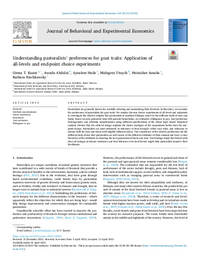Understanding pastoralists’ preferences for goat traits: Application of all-levels and end-point choice experiments

Authors:
Pastoralists are generally known for carefully selecting and maintaining their livestock. In this study, we examine the preferences of pastoralists for goat traits. We employ discrete choice experiments of all levels and endpoints to investigate the relative weights that pastoralists in southern Ethiopia attach to the different traits of does and bucks. Based on data generated from 600 pastoral households, we estimated willingness to pay, trait preference heterogeneity, and attribute nonattendance using different specifications of the mixed logit model. Empirical analysis showed that the all-level design explains the choice strategies of the respondents better than the end-point design. Pastoralists are most interested in tolerance to heat/drought, white coat color, and tolerance to disease both for does and bucks with slightly different orders. The consistency of the relative preferences for the different traits shows that pastoralists are well aware of the different attributes of their animals and have a clear hierarchy of the attributes in choosing the next generation of bucks and does. Our findings imply that breeds with clear advantages in disease resistance and heat tolerance over local breeds might help pastoralists improve their livelihoods.
